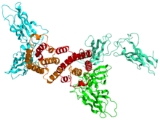
Interferon-gamma receptor
Encyclopedia
The interferon-gamma receptor (IFNGR) is a receptor which binds interferon-γ
, the sole member of interferon type II
.
and IFNGR2
. In unstimulated cells, these subunits are not preassociated with each other but rather associate through their intracellular domains with inactive forms of specific Janus family kinases ( Jak1 and Jak2). Jak1 and Jak2 constitutively associate with IFNGR1 and IFNGR2, respectively. Binding of IFN-γ to IFNGR1 induces the rapid dimerization of IFNGR1 chains, thereby forming a site that is recognized by the extracellular domain of IFNGR2. The ligand-induced assembly of the complete receptor complex contains two IFNGR1 and two IFNGR2 subunits which bring into close juxtaposition the intracellular domains of these proteins together with the inactive Jak1 and Jak2 kinases that they associate with. In this complex, Jak1 and Jak2 transactivate one another and then phosphorylate IFNGR1, thereby forming a paired set of Stat1
docking sites on the ligated receptor. Two Stat1 molecules then associate with the paired docking sites, are brought into close proximity with receptor-associated activated JAK kinases, and are activated by phosphorylation of the Stat1. Tyrosine-phosphorylated Stat1 molecules dissociate from their receptor tether and form homodimeric complexes. Activated Stat1 translocates to the nucleus and, after binding to a specific sequence in the promoter region of immediate-early IFN-γ-inducible genes, effects gene transcription
.
Interferon-gamma
Interferon-gamma is a dimerized soluble cytokine that is the only member of the type II class of interferons. This interferon was originally called macrophage-activating factor, a term now used to describe a larger family of proteins to which IFN-γ belongs...
, the sole member of interferon type II
Interferon type II
A sole member makes up the type II IFNs that is called IFN-γ . Mature IFN-γ is an anti-parallel homodimer, which binds to the IFN-γ receptor complex to elicit a signal within its target cell...
.
Structure and function
The human interferon-gamma receptor complex consists the heterodimer of two chains: IFNGR1Interferon gamma receptor 1
Interferon gamma receptor 1 also known as CD119 , is a human gene.- Function :...
and IFNGR2
Interferon gamma receptor 2
Interferon gamma receptor 2 also known as IFNGR2 is a protein which in humans is encoded by the IFNGR2 gene.- Function :This gene encodes the non-ligand-binding beta chain of the gamma interferon receptor...
. In unstimulated cells, these subunits are not preassociated with each other but rather associate through their intracellular domains with inactive forms of specific Janus family kinases ( Jak1 and Jak2). Jak1 and Jak2 constitutively associate with IFNGR1 and IFNGR2, respectively. Binding of IFN-γ to IFNGR1 induces the rapid dimerization of IFNGR1 chains, thereby forming a site that is recognized by the extracellular domain of IFNGR2. The ligand-induced assembly of the complete receptor complex contains two IFNGR1 and two IFNGR2 subunits which bring into close juxtaposition the intracellular domains of these proteins together with the inactive Jak1 and Jak2 kinases that they associate with. In this complex, Jak1 and Jak2 transactivate one another and then phosphorylate IFNGR1, thereby forming a paired set of Stat1
STAT1
STAT1 is a member of the Signal Transducers and Activators of Transcription family of transcription factors. STAT1 is involved in upregulating genes due to a signal by either type I, type II or type III interferons...
docking sites on the ligated receptor. Two Stat1 molecules then associate with the paired docking sites, are brought into close proximity with receptor-associated activated JAK kinases, and are activated by phosphorylation of the Stat1. Tyrosine-phosphorylated Stat1 molecules dissociate from their receptor tether and form homodimeric complexes. Activated Stat1 translocates to the nucleus and, after binding to a specific sequence in the promoter region of immediate-early IFN-γ-inducible genes, effects gene transcription
Transcription (genetics)
Transcription is the process of creating a complementary RNA copy of a sequence of DNA. Both RNA and DNA are nucleic acids, which use base pairs of nucleotides as a complementary language that can be converted back and forth from DNA to RNA by the action of the correct enzymes...
.

